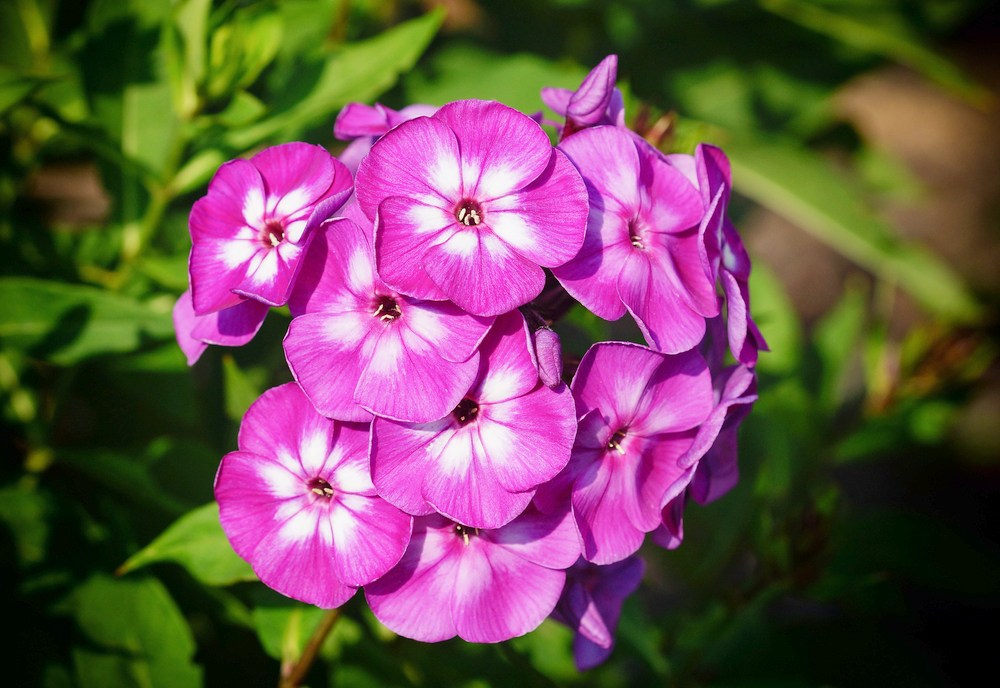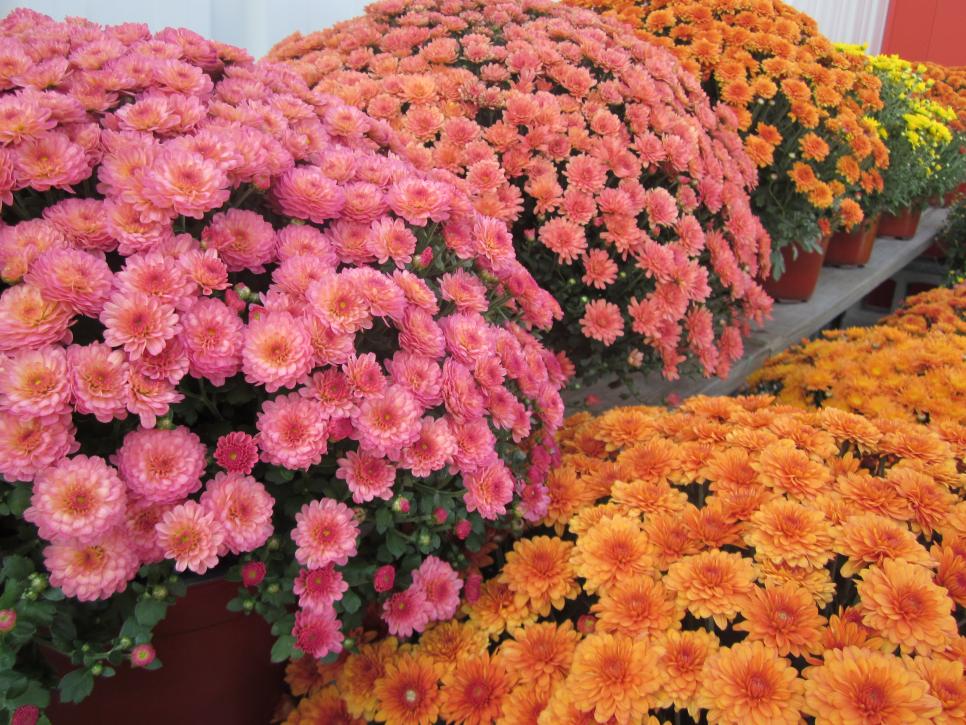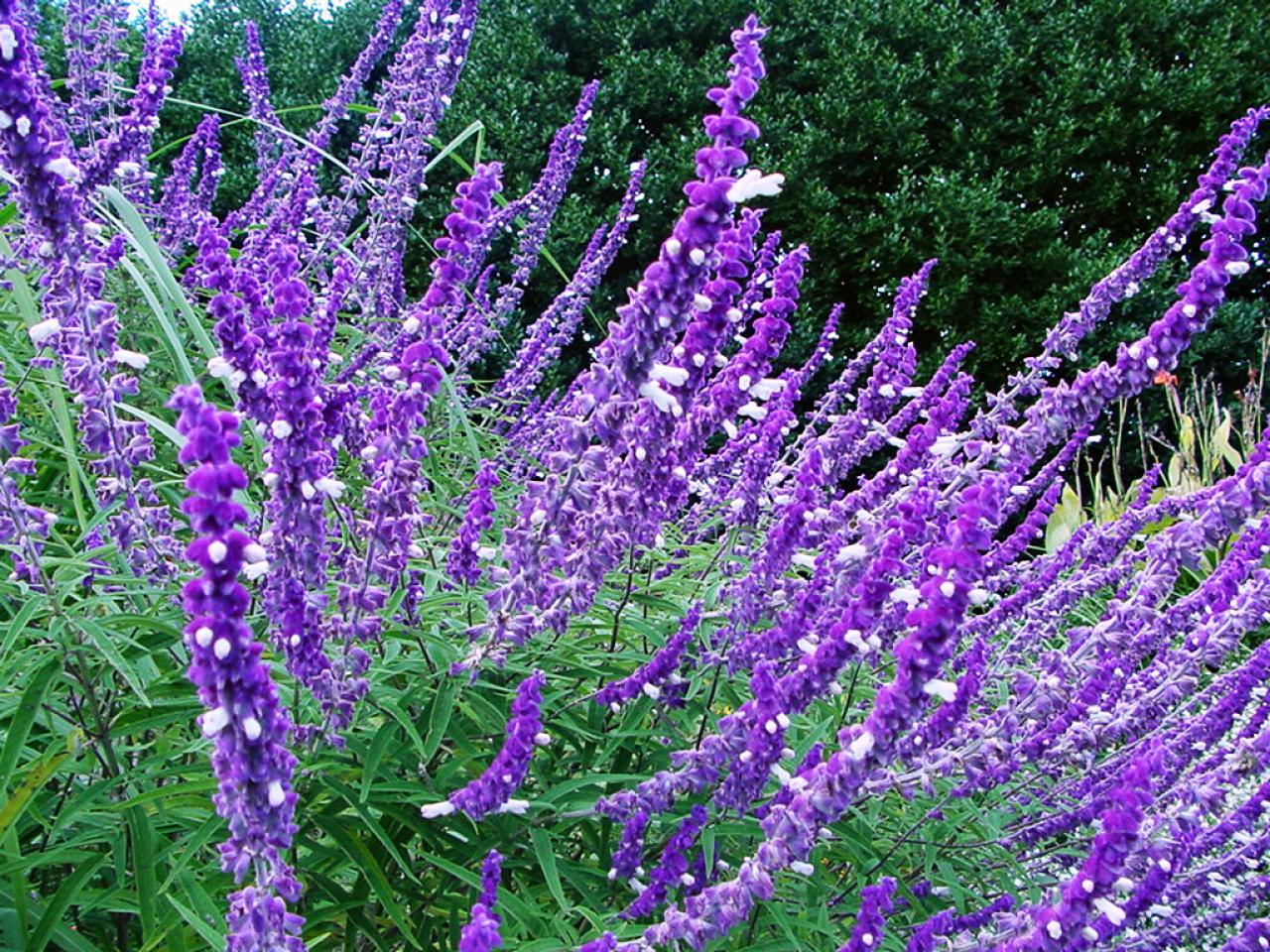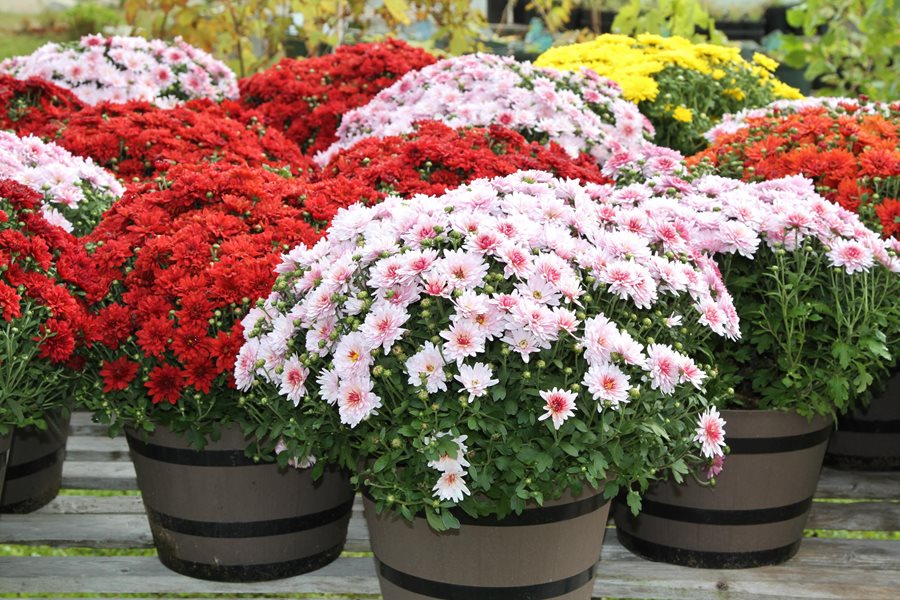Anise Hyssop looks spectacular in the perennial fall garden with its tall spikes of appealing lavender flowers and an aromatic anise-like scent. Hummingbirds, bees, butterflies, and pollinating insects all find this native flower irresistible and swarm the plant when it is in bloom. Anise Hyssop plants grow inches tall, and they have toothed muted green leaves. The flower spikes, covered with hundreds of densely packed little tubular purple blooms, rise up above the foliage, announcing themselves to the world. Anise Hyssop is part of the mint family, but it doesn't have the same invasive tendencies as most mints.
The flowers bloom for months, from late summer through fall. This Hyssop is exceptionally low-maintenance and deer resistant. "Alabaster" has white flowers and light green foliage, "Blue Blazes" is a taller version with purple flowers, and "Black Adder" has reddish-violet blooms. Perennial Hibiscus,such as ourSummerific® series, is another class that will add color to the summer and fall garden. They actually start to bloom in mid-summer, but will continue to bloom deep into fall - October up in Michigan. The color range is pink, white, lavender and red, with some gorgeous bicolors.
The plants are quite heat tolerant and prefer consistently moist soil. In general, they are hardy in zones 4-9 and are quite large feet tall and wide. However, more compact versions such as Summerific® 'Cranberry Crush,' which is 3-4 feet tall, do exist. Asters and hardy mums are the two most traditional perennials to grow for fall flower color. Hardy mums are about as easy to grow as a perennial gets.
They come in great autumnal colors - yellow, bronze, red, white, orange, burgundy and pink and are usually hardy in zones 5-9. When buying mums be sure you distinguish between hardy and florist mums. Mums prefer a sunny spot in the garden with well-drained soil. Avoid locations where water stands after a heavy rain. To get the best bloom on large-flowering types, pinch off all the buds in late May.
This will encourage more compact growth and additional blooms. In northern parts of their range, apply a winter mulch to protect mums from sub zero temperatures. If your mums grow too large, divide them in the early spring every two to three years. After a few years some mums may begin to weaken or die out.
Add new plants every year or two to keep the fall color show going. Deer and rabbits generally avoid dining on mums. Planting chrysanthemum in the spring gives the perennial plant time to establish and adapt to its new garden home. You'll easily find mums in garden centers and nurseries in both fall and spring, but planning ahead is key to successful planting. Planting in the spring will also result in a bigger bloom the following season.
Although some fall mums can survive winter if planted immediately, the odds are much better with spring-planted mums. Plant mums as soon as the soil warms in the spring. From late spring to mid-summer, pinch back the tips and flower buds on all shoots to make the plant bushier and prepare it for a dramatic fall show. For optimal blooming, the plants should be fertilized regularly throughout the growing season. After the blooms fade, cut the plants down to about 6 inches, and cover them with straw or another dry mulch to protect the roots over winter. Established plants should be lifted and divided every two to three years.
That's what you'll get when you put a generous helping of chrysanthemums in your flower border or containers. Generally sold in ready-to-bloom form, mums provide a fall finale of color to any setting. They come in a wide variety of flower colors and shapes, from small button-sized blooms to giant corsage-worthy flowers.
Mum colors include white, yellow, pink, orange, red, burgundy, cream, salmon, and bi-color. There are also dwarf forms that grow just 8 to 10 inches tall and standards that can reach 3 feet in height. Mums are very popular with bees and butterflies, too. A stunningly tall native flower, Joe Pye Weed is superb in the fall perennial garden. It blooms from late summer through fall and produces massive, broad, slightly rounded clusters of dark purple or pink flowers .
Joe Pye plants grow up to 6-8 feet tall, making them an impressive garden addition that is sure to be appreciated by all who see them. Joe Pye Weed is excellent as a background plant, centerpiece, or planted along pathways as a dramatic statement. It is rarely bothered by insects, pests, or disease, and deer generally avoid it.
As if that isn't enough, this perennial smells like sweet vanilla. We usually associate Crocus blooms with spring, but here is a flower that brings some lovely crocus-like spirit to the fall garden! Autumn Crocuses aren't a real Crocus; they belong to the Colchicum/Lily family, while true Crocus flowers belong to the Iris family. However, these not-really-Crocus Autumn Crocus flowers are just as cheerful and wonderful as their spring-blooming look-a-likes. Autumn Crocus plants feature dark-green leaves that resemble tulip foliage. The flowers are wide, goblet-shaped, and light pink or purple, or white.
Autumn Crocus plants grow 8-14 inches tall and burst into bloom in early fall. Each flower bulb produces 1-10 stalks, and each stalk holds a single flower. The clumping growth makes it look like a flower bouquet emerging from the ground. The flower stalks appear after the leaves have died off, which can be confusing since it seems like the whole plant died. The best gardens have plants that add color and interest in all seasons.
Spring and summer are usually pretty simple to fill with color. It can take a bit more planning to keep the garden looking great late summer into fall and winter. However, with a bit of careful plant selection your garden can brim with interest in every season. The plants that are a bit overlooked are perennials and shrubs that flower, fruit or have showy foliage in fall. Why should your summer garden get all the glory?
When the warm weather begins to wind down, the show doesn't have to be over! By planting fall flowers, you can enjoy colorful bloomers until the first hard freeze. Fall-friendly shrubs, annuals, and perennials, which come back every year, add another layer of depth to your landscape—not to mention beautiful fall mums.
In warmer winter climates, they can be cut back to 6" tall after flowering. Check your local garden center to see what varieties work best in your area. These plants start to bloom in the mid summer and continue to become deeper in color into the Fall months, giving you color for many months. Hibiscuses are also very heat tolerant and prefer consistently moist soil.
The thrive best in zones 4-9 and are pretty big plants, growing to be 4 or 5 feet tall and wide. If your landscape needs something a bit smaller, there's a more compact version such as "Cranberry Crush" that's only 3 or 4 feet tall. One of my favorite plants for this time of year is fall-blooming Sedums.
They are heat and drought tolerant, don't mind poor soils, are generally hardy in zones 4-9 and begin blooming in late summer. The color range is white, pink, red, burgundy and lavender. Some of my favorites are 'Pure Joy,' Garnet Brocade™, 'Maestro,' Autumn Joy and Neon. Good drainage is especially important for successful overwintering. We trim the plants back before shipping to promote bushiness, but any ambitious shoot which is getting ahead of the plant should be tipped back. All growing tips should be pinched back until the 4th of July.
Can be divided in spring if needed or if center of clump is not producing new growth. Mulch for winter protection only in very cold areas and be sure to remove the mulch before the spring thaw. 'Walker's Low' is named for a garden in England, not for its height. It grows as high as 30" and can spread to 3 feet wide. Lavender blue flowers bloom profusely in early summer, as early as April or May in warmer climates, and then sporadically until frost. Sheering after the first heavy blooming will encourage another bloom, but the plant will not reach 30".
Sheering will also keep the foliage neat and fresh. The spicy scent is a nice addition to a vase of cut flowers, or in potpourri. In addition to attracting cats, 'Walker's Low' will attract bees, hummingbirds and butterflies. Deer and rabbits are indifferent to the plant, being scented and gray foliage.
'Walker's Low' is hardy enough for zone 4 and will tolerate sandy soil, salt, humidity and drought. Seeds are sterile, so this perennial must be propagated by division. Korean chrysanthemums are later blooming and have a softer form than typical garden mums. The foliage of Korean mums forms an attractive mounding shape all season long, even before the plant covers itself in daisy-like autumn blooms. The plants also tend to be pest and disease resistant and long-lived.
Such a reliably hardy, late-blooming perennial should be much better known. Grow with sedums such as 'Autumn Joy,' goldenrods, or Russian sage. These heat and drought tolerant beauties are tough cookies, thriving in even poor soil. They are hardiest in zones 4-9, but some varieties can have specific zone preferences, so double check when you're picking them out! They start blooming in late summer and will give a color range from white, pink, red, burgundy and lavender. Mums aren't exactly "pruned," but are instead pinched throughout the growing season.
This helps the plant branch out, become fuller and offer more blooms. When your plant reaches 6 inches tall in the spring, simply pinch off 1 inch of each shoot. Repeat this every 2 to 3 weeks until early summer.Deadhead spent blooms throughout the fall for an extended bloom time. Once the plant has died in the winter, resist cutting it back. Research reveals that allowing it to die back naturally over the winter produces a stronger plant. Simply clean up the dead stems and foliage in the spring.
However, there are varieties that are truly perennial in most climates when planted in the early spring or in the fall several weeks before the first frost. These plants grow fast, and you should have flowers in the first growing season. Bloom times vary with variety and climate from early September through mid-October. While the purple fountain grasses are annuals, Pennisetum 'Desert Plains' is hardy in zones 5-9. It tops out at 4 feet tall and is about that wide.
The more sun you can provide, the happier this plant is. In mid-summer the foliage tips begin to turn deep red and by fall the whole plant is shades of gold and orange. It blooms in fall, with the large plumes emerging purply-pink and aging to tan. It is often considered to be the best hardy Pennisetum available. 'Cheyenne Sky' is a compact form of switch grass, topping out at 3 feet tall, including flowers.
It is great in landscapes and containers and works well when planted in a mass, although it does well as a specimen, too. It starts out green in spring, but by late summer the foliage is wine-red, as are the flowers that are in full show. Unless the snow is very heavy, it will remain standing through the winter where it provides cover to birds.
And believe it or not, fall is a great time to plant perennials and shrubs when temperatures are less extreme and rainfall is plentiful. Just be sure to give plants plenty of time to establish roots before winter. That's about six weeks before the ground freezes, or typically no later than mid-November for most of the country. To give your plant a good start in life, read the plant tag or description to see what kind of light it needs. For example, full sun means an area gets six or more hours, while part sun is about half that.
When choosing perennials and shrubs, make sure they can handle winters in your USDA Plant Hardiness Zone. Below, check out our favorite fall flowers every gardener needs. Even when it's not blooming, sedum 'Frosted Fire' plays beautifully with mums, thanks to its variegated creamy yellow and light green foliage. The rose-pink flowers start in late summer, drawing butterflies until they fade in fall.
You can find sedums that tolerate partial shade, but most prefer full sun and need very little care. Persicifolia blooms white or blue in early summer and is 2 to 3 feet tall with strong stems. It tolerates dry shade, and is easy to grow from seed. Very heat and cold tolerant, it is hardy to zone 4. There are thousands of Begonia species, but sadly most are annuals for us in the United States.
However, this one small species, the Hardy Begonia, is cold-tolerant, and it's an absolute wonder in the perennial fall garden. The leaves are olive-green and shaped like enormous wings , with red veins on the undersides. Hardy Begonia flowers are dainty, pink four-petaled gems with bright yellow pom-pom stamens that stick out from the center. When in bloom, the flowers dangle from arching red stems just above the foliage. From the middle of summer well into fall, the flowers bloom continuously, adding a sweet delicacy to the garden. Hardy Begonias prefer partially shaded locations, and even when not in bloom, the large, winged foliage is quite attractive.
In late summer when other plants call it quits, mums hit their stride. Like poinsettias, they're photoperiodic, meaning they rely on specific amounts of light to send the signal that it's time to start putting on a show. Garden mums are short-day plants and initiate flower buds in response to an interaction of day length, temperature and plant age. On average, garden mums will not start to set buds until the nights last about 10 hours long.




























